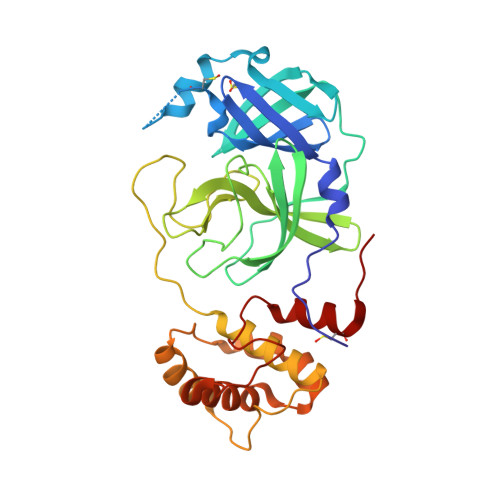An Azapeptide Platform in Conjunction with Covalent Warheads to Uncover High-Potency Inhibitors for SARS-CoV-2 Main Protease.
Khatua, K., Alugubelli, Y.R., Yang, K.S., Vulupala, V.R., Blankenship, L.R., Coleman, D.D., Atla, S., Chaki, S.P., Geng, Z.Z., Ma, X.R., Xiao, J., Chen, P.C., Cho, C.D., Vatansever, E.C., Ma, Y., Yu, G., Neuman, B.W., Xu, S., Liu, W.R.(2023) Biorxiv
- PubMed: 37090597
- DOI: https://doi.org/10.1101/2023.04.11.536467
- Primary Citation of Related Structures:
7SH7 - PubMed Abstract:
Main protease (M Pro ) of SARS-CoV-2, the viral pathogen of COVID-19, is a crucial nonstructural protein that plays a vital role in the replication and pathogenesis of the virus. Its protease function relies on three active site pockets to recognize P1, P2, and P4 amino acid residues in a substrate and a catalytic cysteine residue for catalysis. By converting the P1 Cα atom in an M Pro substrate to nitrogen, we showed that a large variety of azapeptide inhibitors with covalent warheads targeting the M Pro catalytic cysteine could be easily synthesized. Through the characterization of these inhibitors, we identified several highly potent M Pro inhibitors. Specifically, one inhibitor, MPI89 that contained an aza-2,2-dichloroacetyl warhead, displayed a 10 nM EC 50 value in inhibiting SARS-CoV-2 from infecting ACE2 + A549 cells and a selectivity index of 875. The crystallography analyses of M Pro bound with 6 inhibitors, including MPI89, revealed that inhibitors used their covalent warheads to covalently engage the catalytic cysteine and the aza-amide carbonyl oxygen to bind to the oxyanion hole. MPI89 represents one of the most potent M Pro inhibitors developed so far, suggesting that further exploration of the azapeptide platform and the aza-2,2-dichloroacetyl warhead is needed for the development of potent inhibitors for the SARS-CoV-2 M Pro as therapeutics for COVID-19.
















